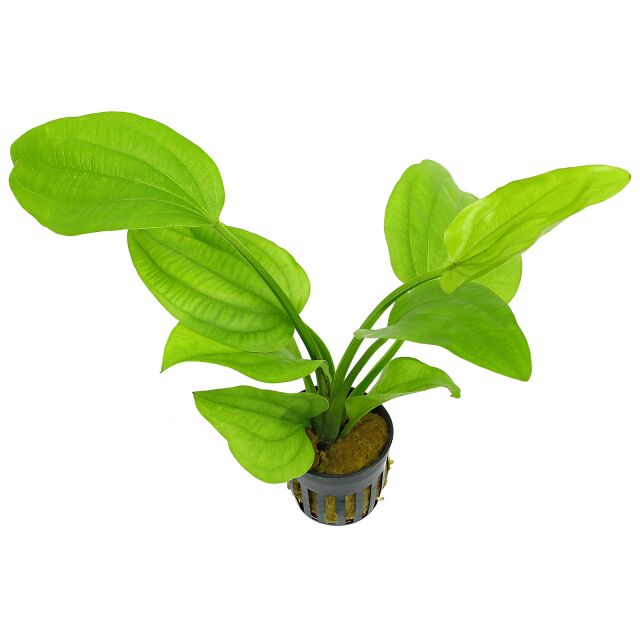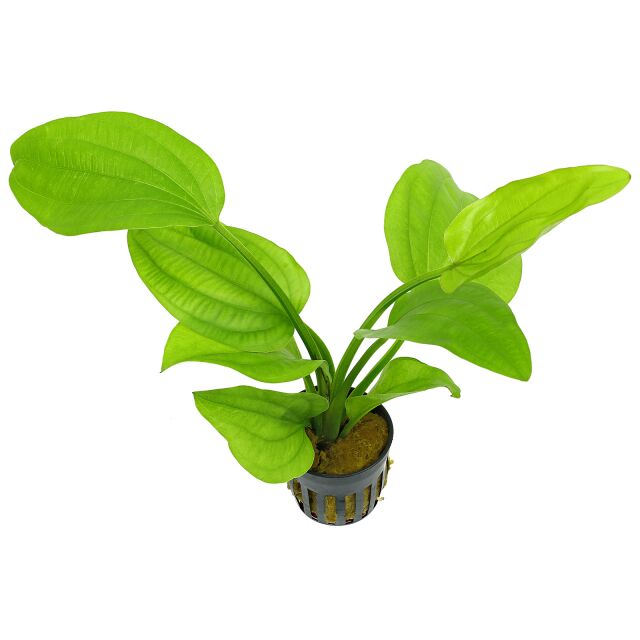


Echinodorus sp. "muricatus"
- Entirely green solitary plant
- Elongate, ovate leaves
- No high demands
- Comparatively fast growing
Sign in or Register
Item question
We’re here for you!
Please enter your question and e-mail and we’ll contact you as soon as possible. It usually takes us up to 24 hours during business days to respond.
Thank you for your question!
Thank you, we’ll get in touch!
Close window
You already sent us a question.
Please wait a few minutes
Description
For a long time, the name "Echinodorus muricatus" is applied to various plants in the aquarium trade. It is actually a synonym of Echinodorus floribundus. However our plant with the label E. muricatus seems to be close to Echinodorus cordifolius, also a hybrid cannot be excluded. In its terrestrial form, it develops elongate-ovate, medium green leaves and is about 30 cm tall. The submerged leaves have a more elongate shape. The plant resembles Echinodorus cordifolius "Fluitans" but differs by broader leaf blades.
The plant is mostly delivered in its emersed (terrestrial) form with long stalked aerial leaves, but after planting into the tank shorter stalked submerged leaves will appear, and the older emersed foliage can be cut off. As well as other Echinodorus, it benefits much from nutrient supply by the substrate. CO2 supply is not strictly necessary but may enhance its growth. Under favorable conditions inflorescences with adventitious plantlets can be expected. When the young plants are strong enough, they can be cut off and replanted.
In contrast to the many red or strikingly spotted Echinodorus hybrid cultivars, Echinodorus sp. "fluitans" it has a natural appearance due to its modest green coloration. It is also interesting as emersed plant for paludariums and Wabi-Kusa.
The species name Echinodorus muricatus is a synonym of Echinodorus floribundus (= E. grandiflorus ssp. aureus) (see the respective data sheet).
The sword plant we describe here can be found in trade under the name E. muricatus but does not really belong to that species. For this reason, we put this name in quotation marks here. This plant rather seems to belong to the complex of E. cordifolius, but it might also be some sort of hybrid. It is possible that further Echinodorus forms are sold under the name "E. muricatus", too.
This sword plant is a rather fast grower and forms a large, wide leaf rosette in the aquarium. Its submersed leaves are longish-ovate to lanceolate and of a medium green colour. They are slightly transparent and look a little like the leaves of some varieties of Echinodorus uruguayensis. The leaf stalks are in most cases far shorter than the leaf blade. (read more)
| Family | Alismataceae |
| Genus | Echinodorus |
| Difficulty | easy |
| Usage | Semi-emersed plant for open tanks, Background |
| Height | 30 - 50cm |
| Width | 20 - 40cm |
| Growth | fast |
| pH value | 5 - 8 |
| Temperature tolerance | 15 - 30°C |
| Carbonate hardness | 0 - 21°dKH |
| General hardness | 0 - 30°dGH |
| Propagation | Proliferating inflorescences, Rhizomteilung, Splitting, cutting off daughter plants |
| Can grow emersed? | yes |
| Source | Flowgrow |
| Family |
| Alismataceae |
| Genus |
| Echinodorus |
| Difficulty |
| easy |
| Usage |
| Semi-emersed plant for open tanks, Background |
| Height |
| 30 - 50cm |
| Width |
| 20 - 40cm |
| Growth |
| fast |
| pH value |
| 5 - 8 |
| Temperature tolerance |
| 15 - 30°C |
| Carbonate hardness |
| 0 - 21°dKH |
| General hardness |
| 0 - 30°dGH |
| Propagation |
| Proliferating inflorescences, Rhizomteilung, Splitting, cutting off daughter plants |
| Can grow emersed? |
| yes |
| Source |
| Flowgrow |
General information
Please choose a variant to see more information.
| Item no. |
|
| EAN | |
| Weight | |
| Shipping weight |
Customers ask customers
You have questions about this product? Ask other customer or our support team about this product!